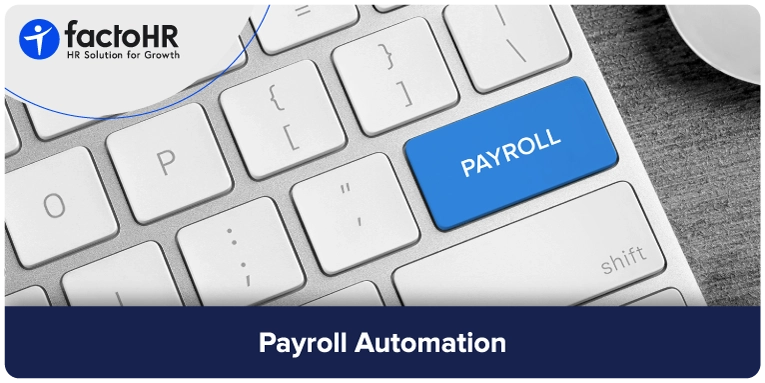Payroll Automation: Free Guide Reduces Payroll Errors

Table of Contents
Automating payroll processes can address several issues, as 60% of organizations already do. Manual payroll processing can lead to penalties for late payments, potentially resulting in employee dissatisfaction.
A scalable payroll automation system would save the time and effort of your HR professionals by automating most payroll processes, such as record-keeping and automated payroll calculations. Modern payroll processing software also generates ready-to-file tax reports through tax automation software. Dashboards with payroll dashboard analytics can also help you optimize your resource allocation and achieve better payroll ROI.
In this guide, you will learn how payroll automation can transform your payroll management processes.

What is Payroll Automation?
Payroll automation is a software-driven process that includes salary and tax calculations, deduction management, payslip generation, and electronic employee payments. It can also be integrated with other HR applications, such as attendance and leave management, reducing manual efforts and increasing data accuracy.
Payroll automation can automate all these repetitive activities. This will free up more time for the HR professional to drive strategic initiatives and focus on employee relations.
Difference between Manual and Automated Payroll Processes
| Aspect | Manual Payroll | Automated Payroll |
|---|---|---|
| Process | Relies on spreadsheets and manual data entry. | All components are automated, and data is transferred between systems through integration. |
| Time & Effort | Requires more time and human effort. | Completes payroll faster with minimal human intervention. |
| Error Rate | More error-prone due to disparate, hard-to-integrate processes. | Almost error-free, as calculations follow predefined rules throughout the payroll cycle. |
As shown in the table, automated payroll is faster and more reliable compared to manual payroll processes. This is so because, in manual payroll, all the processes are manually calculated. In automated payroll, these processes are automatically calculated using an integrated payroll management system.
Why is Payroll Automation Important?
Automating payroll is important as it enhances accuracy, speeds up processing, boosts productivity, and improves overall efficiency.
- Improved accuracy and reduced payroll errors. Integration with other systems facilitates seamless data transfers. Similarly, automatic calculations ensure error-free calculation of tax components and other salary heads.
- Enhanced compliance with tax laws and regulations. Ready-to-file reports and auto-generated tax forms help in filing taxes. Real-time updates simplify compliance with labor regulations.
- Increased productivity by saving HR time. HR professionals can participate in other critical processes, such as decision-making, as they would not be required to oversee manual payroll processes.
- Better employee satisfaction through timely and accurate payments. Single-click payroll processes make sure that employees receive their fair compensation on time. Additionally, integration with bank APIs enables the direct transfer of salaries to employees’ bank accounts.

Challenges of Manual Payroll Processing
Difficulties in managing leaves, payroll errors in tax calculations, waste of valuable time, and issues in complying with labor regulations are some of the common challenges associated with manual payroll.
Time-Consuming Calculations and Data Entry
Manually entering all the data related to payroll could consume valuable time for your HR and finance professionals. Similarly, manually calculating all tax deductions could result in payroll errors when preparing tax reports.
Error-Prone Calculations
Errors in tax calculations can be costly for both employees and employers. Tax formulas change frequently. So, calculating deductions manually is a complex process.
Difficulty Complying with Regulations
You’d need to keep track of all updates, such as amendments, notifications, and subsequent rule changes, manually and in separate documents. This would make it more difficult to comply with regional regulations. You could also face these challenges, including legal consequences if you fail to comply with government laws.
Lack of Transparency for Employees
Calculating all the salary components manually could result in delays. Subsequently, employees would not be able to access all the salary heads at the time of salary distribution. This could lead to employee discontent due to a lack of transparency and inefficient processes. A self-service portal can help you be more transparent, as it provides employees with real-time updates related to payroll information.
What are the Benefits of Payroll Automation?
Automating payroll processes can save time, reduce payroll errors, optimize resources, and enhance overall productivity within your workforce.
Time Savings
The best payroll system would automate most of the calculations. Some advanced systems even allow for bulk approvals. This speeds up the payroll processes and saves time.
Cost Efficiency
Manual payroll processing creates a need for more employees. While automated payroll does require oversight, it doesn’t require a large number of employees to perform manual processes.
Scalability
Automating payroll processes would make it easier for HR professionals to manage payroll for a large workforce.
Integration with Other Systems
Advanced digital solutions also integrate with other systems, such as attendance, leave, performance, and travel modules. This would simplify the management of leaves, settlement of claims, tracking of attendance, and provision of performance-linked bonuses.

How Payroll Automation Works
In payroll automation, software is used to automate all payroll processes, including salary distribution, tax calculations, reporting, and the generation of payslips. The following features are necessary for automating payroll.
Data Management
The system tracks all employee information, such as data, attendance, and leave records. It also manages salary details and other relevant information. This step eliminates manual data entry and reduces the chance of payroll errors, thereby streamlining the process.
Automated Salary Calculations
The automation software calculates all salaries based on predefined rules for base pay, allowances, and deductions.
Simplified Tax Filing
The software calculates taxes effortlessly. The software adheres to the latest tax rules and regulations, including income tax, TDS (Tax Deducted at Source), and Professional Tax. E-filing forms for submission to authorities can also be prepared.
Secure Payment Processing
It enables safe and on-time salary disbursement directly to banks or via any other electronic payment mode. This will eliminate risks associated with manual check handling and ensure that the staff members’ payments are made on time.
Powerful Reporting and Analytics
Auto-generated reports can provide scores of insights into your payroll data. These include payroll trends, cost breakdowns, or suggestions for improving HR decisions.
Apart from these core functionalities, automated software can seamlessly integrate with the following HR systems:
Attendance Management Systems
Data from the attendance management system is automatically transferred, eliminating the painful process of manually entering employee work hours.
Leave Management Systems
Integrate with the leave management system to enable accurate employee leave deductions.
Employee Self-Service Portals
Empower your staff with self-service access to payslips, tax forms, and all other relevant payroll information. This will lessen HR’s administrative workload and increase employee satisfaction.
What are the Key Features to Consider in Payroll Automation Software?
When selecting payroll software, consider the features that best suit your needs. Here are some of the must-have features.
User-Friendly Interface
All the professionals might be tech-savvy. Your chosen payroll solution should have an easy-to-use interface for performing all the payroll processes. Both employers and employees should have access to all features.
Integration Capabilities
A payroll software should seamlessly integrate with other modules, such as performance and leave management. A smooth integration ensures that all data can be migrated without issues related to data fragmentation.
Customizable Reporting and Analytics
Leaders should be able to receive customized reports on time, as such reports are crucial for informed decision-making. They should also be able to access workforce management-related costs on a clutter-free dashboard.
Security and Compliance Features
Features like end-to-end encryption and multi-factor authentication ensure data security and payroll protection. Payroll compliance management, which involves adhering to various regulations, is equally important.
Mobile Accessibility
At a time when smartphones are replacing physical offices, it is paramount that employees and employers have access to payroll-related information on a mobile app.
Cloud-Based Operations
Cloud-based payroll systems enable secure data transfer and real-time access to reports while maintaining audit readiness.

Best Practices for Implementing Payroll Automation
Businesses should understand their needs, compare and evaluate available payroll solutions, and ensure that their HR and finance teams are well-trained to manage payroll with software.
Conduct a Thorough Needs Analysis
Needs analysis is the first step before choosing any solution. Ask yourself, why do you need a payroll management system? There could be several reasons, but prioritize those that matter most to you as a business.
Choose the Right Payroll Automation Software
Research scalable payroll solutions through customer reviews and trusted software evaluators. Focus on cloud-based payroll systems that address your specific needs.
Train Your HR and Payroll Teams Adequately
Train your HR and finance staff effectively to maximize the benefits of your chosen capabilities. Prefer a vendor that offers training sessions and support for implementing their payroll software.
Continuously Monitor and Improve Processes
Optimize your payroll processes through continuous monitoring and improvement. Payroll dashboard analytics provide ideal insights for strategic improvements.
The Future of Payroll Automation
The ever-changing landscape of automation is shaping some exciting trends that will define its future.
AI-Powered Automation
Artificial intelligence is the next big thing that will further revolutionize payroll. AI can easily undertake complex tasks. It can analyze payroll data and identify anomalies that may indicate an error or fraud. AI-powered chatbots can answer questions from employees about their payslips and benefits, thus lightening the burden on HR.
Cloud-Based Solutions
Cloud-based payroll technology is rapidly becoming the norm. Benefits include accessible processing from anywhere, enhanced data security, payroll, and automated software updates for seamless management.
Mobile App Integration
Mobile applications are another growing trend. Employee self-service apps allow staff members to access payslips, request leave, and update personal information on the go. This eases employee engagement.
Conclusion
Payroll automation is the future of workforce management. Businesses are increasingly adopting cloud-based payroll solutions to streamline their compliance automation efforts. Small business payroll automation and enterprise payroll solutions provide considerable competitive advantages through digital payroll solutions.
They would not need to pay hefty costs for outsourcing payroll, as their HR professionals can perform payroll in a single click. factoHR, an advanced cloud-based payroll software, is revolutionizing payroll management in over 20 countries.
Notable features include automated tax calculation, real-time payroll updates, comprehensive HR payroll integration, and AI-powered chatbots. Transform your payroll processes with scalable payroll solutions today!

FAQs
1. How does Payroll Automation Benefit My Business?
Digital payroll solutions save time, enhance accuracy, reduce compliance risks, and increase employee satisfaction. Automating these tasks enables HR professionals to focus on strategic activities and employee relations while improving payroll cost efficiency.
2. What Should I Consider when Choosing Automated Software?
Consider your business’s size and needs when selecting an enterprise payroll solution. Ensure scalable performance and compliance with regulations. Verify data security, payroll features, and user-friendly interfaces. Evaluate payroll ROI and seamless integration with existing HR systems.
3. Can Payroll Automated Software Integrate with My Existing HR Systems?
Yes, most advanced payroll automation systems integrate with existing HR systems through HR payroll integration, including attendance management integration and leave management systems. This enables seamless workflows across all HR processes.
4. What are the Future Trends in Payroll Automation?
Future trends include AI-powered automation, cloud-based payroll solutions, and the integration of employee self-service portals. Intelligent systems will analyze payroll dashboard analytics, while advanced cloud payroll offers secure access and automated updates. Mobile apps will enhance engagement by providing accessible payslips and leave requests.
Grow your business with factoHR today
Focus on the significant decision-making tasks, transfer all your common repetitive HR tasks to factoHR and see the things falling into their place.

© 2025 Copyright factoHR


